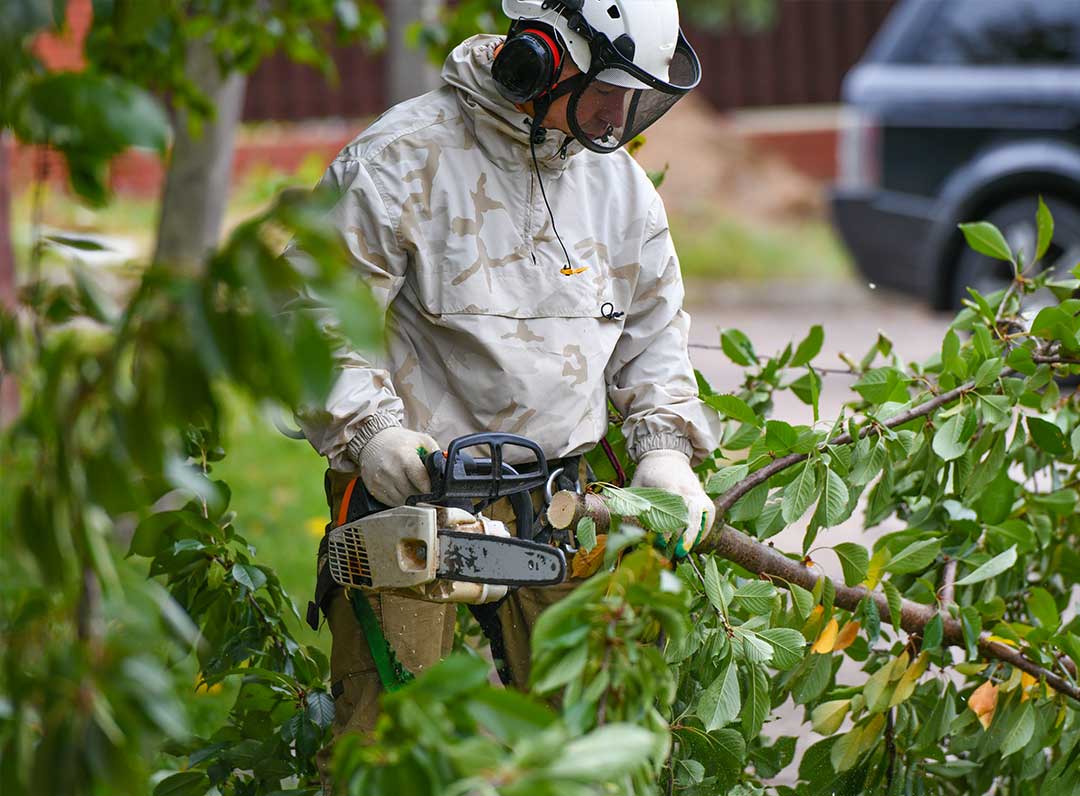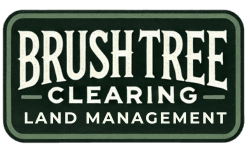How Does a Tree Service Cut Down a Tree?
Hey there! Ever wonder how professionals cut down those big, towering trees safely? It’s not just about grabbing a chainsaw and yelling “Timber!”—though that does happen sometimes. At BrushTreeClearing.com, we’re experts in tree removal, and today, I’m going to break it down for you, step by step. Ready to learn how the pros do it? Let’s get chopping!
Step 1: Check Out the Tree (and What’s Around It)
Before we do anything, we have to take a good look at the tree. Is it tall? Is it leaning in a weird way? Is it close to your house, a power line, or your grandma’s favorite garden gnome? We want to make sure we know exactly where this tree is going to fall, so we don’t accidentally squish something important!
We also check if the tree is healthy or if it has any disease or damage. Sometimes, sick trees can be unpredictable, and we need to handle them carefully.
Step 2: Plan the Cut (It’s Like Tree Surgery!)
Next, we plan how we’re going to cut down the tree. Think of it like a puzzle! We decide which way the tree is going to fall (usually where there’s nothing in the way), and we pick our tools—chainsaws, ropes, or maybe even a tall ladder. And don’t forget, we always wear helmets, gloves, and other safety gear. Safety first!
Step 3: Time to Make the First Cut
Here’s where the real action begins! We start by making something called an undercut or notch cut. This is a V-shaped cut on the side where we want the tree to fall. It kind of looks like a slice of pizza (but please don’t eat it).
Then, we go to the opposite side of the tree and make the back cut. This is where the magic happens! The tree will start to tip over in the direction of the notch cut. If we did everything right, it should fall exactly where we planned. If we didn’t… well, that’s why we have a backup escape route!
Step 4: TIMBER!
Once the tree starts falling, everyone clears the area—no one wants to be under a falling tree! Sometimes, we use ropes or special equipment to guide the tree down gently. If there are buildings or other things nearby, we might even take the tree down piece by piece. It’s like a tree jigsaw puzzle, but way cooler (and with more sawdust).
Step 5: Clean Up the Mess (Because We’re Not Leaving You with a Giant Log in Your Yard)
After the tree is down, it’s time to clean up. We chop the big branches into smaller pieces, and sometimes we even bring in a wood chipper to turn them into mulch. (The wood chipper is like a giant blender for tree branches—it’s loud, but it’s awesome.)
We can haul away the tree or, if you want, leave the wood for firewood or other projects. Some people even like to keep a slice of the tree trunk as a souvenir—talk about tree-mendous memories!
Bonus Round: What About the Stump?
Now, we can’t forget about the tree stump. If you don’t want a stump left in the ground (and trust me, those things can be tripping hazards), we can use a stump grinder to grind it down. This machine chews up the stump until it’s below ground level, making it easier to plant grass or do other yard work. No more stubbed toes!
Why Do We Cut Down Trees Anyway?
You might be thinking, “Why would anyone want to cut down a tree?” Good question! Here are a few reasons:
- It’s sick or damaged: Sometimes trees get diseases or pests that can make them dangerous.
- It’s too close to something important: If a tree is leaning over your house, you might not sleep so well at night!
- Storm damage: A storm can break branches or even tip the tree over, making it unsafe.
- You need more space: Maybe you’re putting in a pool or building a treehouse (though, honestly, trees are great for treehouses).
Whatever the reason, when it’s time to remove a tree, it’s always a good idea to call in the pros. Trust me, you don’t want to DIY a tree removal unless you really love splinters and dodging falling branches!
Step 6: Safety First — Cranes, Hoists, and Other Cool Tools
Okay, this part is awesome, so buckle up. Sometimes, a tree is in a spot where simply cutting it down isn’t safe—like if it’s really close to a building, or there’s a chance it could fall the wrong way and cause damage. When we’re dealing with tricky trees like that, we bring in the big guns: cranes and hoists.
Here’s how it works: We use a crane to lift and hold parts of the tree in the air while we cut it down. Imagine it like this—a giant machine ties off the tree and gently lifts sections so they don’t come crashing down. This technique allows us to take down a tree in pieces, rather than risking one big fall. The crane or hoist actually suspends the tree so we can control each piece as we cut it off.
It’s super cool to watch, and it’s especially important in areas where we want to make sure nothing gets damaged. Plus, it means we can work in really tight spots without causing any trouble. You wouldn’t want a tree falling onto your house or car, right? The crane lift makes sure that doesn’t happen!
So, when things get tricky, we go pro with cranes and other heavy-duty equipment. Safety is always the top priority—no matter how cool the equipment is!
Final Thoughts from Your Tree-Cutting Friends
Cutting down a tree might sound simple, but it’s actually a careful, well-planned process that takes skill and the right equipment. At BrushTreeClearing.com, we make sure your tree comes down safely, without damaging your property—or your grandma’s gnome collection. Whether it’s a big tree in a tricky spot or a stump that’s been bugging you for years, we’ve got you covered.
Got a tree that’s gotta go? Give us a call, and we’ll take care of the rest—just sit back and watch the pros in action!
Contact BrushTreeClearing.com today! We’ll make your tree disappear (but in a totally safe and responsible way).
Now that you know how we do it, let us handle the hard work—after all, you don’t want to end up yelling “Timber!” at the wrong time! 😉
Count the garden by the flowers, never by the leaves that fall. count your life with smiles and note tears that roll.

It was popularised in the 1960s with the release of Letraset sheets containing Lorem Ipsum passages, and more recently.


0 Comments